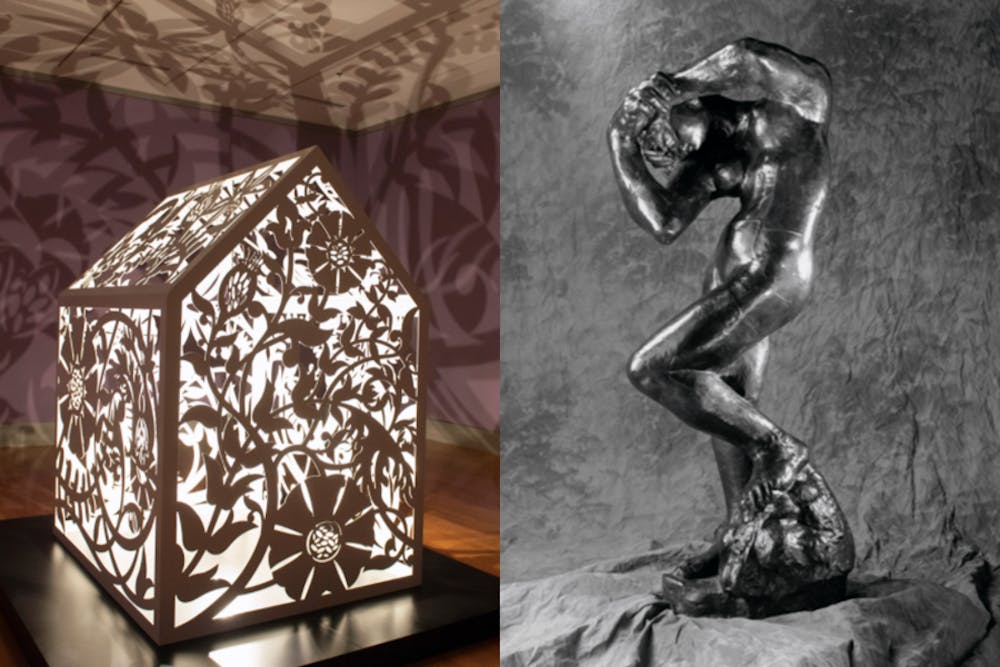Two new exhibitions opened Feb. 19 at the Columbia Museum of Art, "Rodin: Contemplation and Dreams" and "Anila Quayyum Agha: Let A Million Flowers Bloom," bringing with them sculptures, metalwork, a study on human forms and illusions.
The two exhibitions will run until May. "Contemplation and Dreams" displays over 40 bronze works, including famous sculptures like The Burghers of Calais and The Gates of Hell. The artwork in "Contemplation and Dreams" is a part of the collection from Iris & B. Gerald Cantor Foundation with "Let a Million Flowers Bloom" being supported by the City of Columbia.
"Let A Million Flowers Bloom" is two large works, All The Flowers Are For Me (Turquoise) from 2017 and This is NOT a Refuge! from 2019, from Anila Quayyum Agha that are inspired by Islamic architecture. Both are made from metal engraved with different patterns on each. One has the shape of a house and has a flower pattern.
"Things that may happen, like that little boy's photograph or ... putting those bags on the front of the building in the land," Agha said. "So those things can inspire, trigger or point me in a direction where I can start thinking of a project."
Agha is a Pakistani-American contemporary artist born in 1965. Her work sits in the middle of a gallery room, as the light from its center displays shadows of flowers onto the wall. Visitors can see different images projected onto the wall, depending on the angle they look.
Agha wanted the shape of the house and projections from the light and flower engravings to reflect a warm and beautiful refuge, according to Agha's statement of "This is NOT a Refuge". However, the piece "provides neither shelter from the elements nor privacy from prying eyes."
Through her work, Agha said she tries to tell the story of people looking for a sense of belonging. She said she does not want to generalize her work to the term "refuge" but more to people's understanding of displacement.
"When you work and walk into her galleries, those two pieces, they carry with them great stories about her feelings about what it means to be home, and what it means to be an immigrant, and what it means to be different from everyone else around you," Judith Sobol, the curator of collections and exhibitions at the Iris & B. Gerald Cantor Foundation, said.
On the other hand, Rodin is a legendary French artist who was born in 1840. Rodin is the bridge between "the traditional kind of way of doing things and the more modern approach," according to Glenna Barlow, curator of education.
"Rodin's work was revolutionary in his time," Sobol said, "because although his works have stories behind them, he treated the stories as opportunities to show complex, emotional states, not just as sentimental stories about dying for your city."
What also makes Rodin special is his sense of movement.
"Even if a figure is static, you can anticipate how they're going to move," Barlow said.
Barlow said Rodin did not limit himself to only creating things that look like what came before him. He created unique, never-done-before sculptures that are a little rough with angles to them.
Jackie Adams, the director of art and learning at the Columbia Museum of Art, said the museum loved the innovation of the two artists. Rodin broke "rules and physical dynamics" to create sculptures, and, in the same way, Agha broke through using "new materials and processes" to build her works.
Adams said both Rodin and Agha, in their time, dealt with issues of fundamental human struggle. They reflected and responded to the political, human-environment around them and what was going on in their world through art.
Rodin and Anila are living almost a hundred years apart. However, there is a connection between how they use materials and contrast the natural world of flowers and the human body through softness and elegance, versus hard material like metal.
"Rodin is known for his figurative beauty, whereas Anila Agha is known for her patterning beauty," Adams said.

